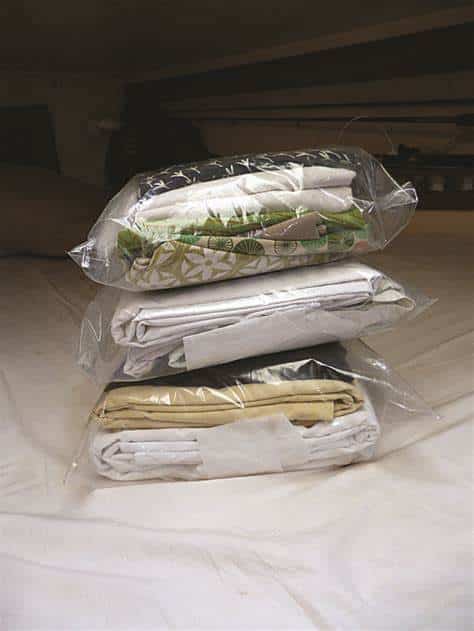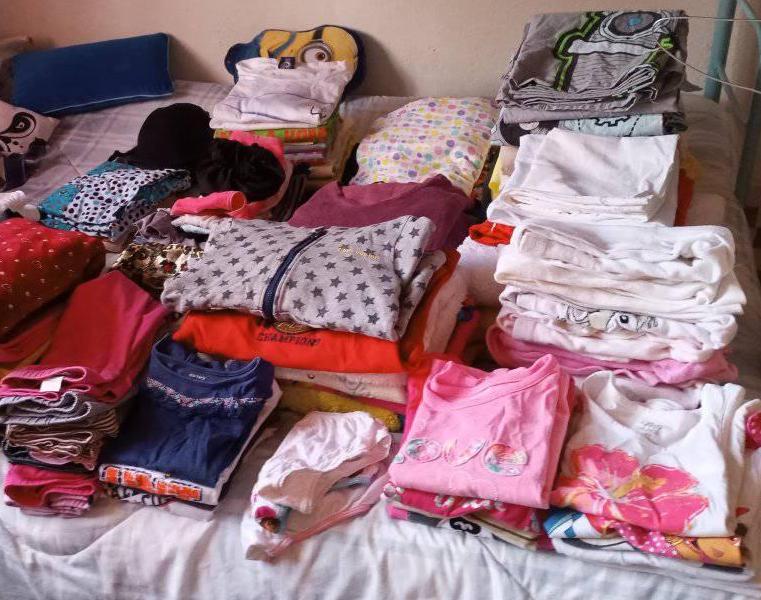If you have had the misfortune of having fleas on your clothes, then you know how uncomfortable it can get. The bites, severe itching, allergic reactions, and even diseases brought upon by flea bites hiding in your clothes are enough to make you toss your clothes away.
You may have come across various flea elimination methods, including bagging them. But does putting clothes in plastic bags kill fleas, or is it just an old wives’ tale?
The only way to ensure fleas do not become a nuisance in your home is to kill them completely. So, let’s find out whether bagging your clothes works.
Does Putting Clothes In Plastic Bags Kill Fleas?
Putting clothes in plastic bags can kill fleas. However, this method relies on depriving fleas of the conditions they need to survive rather than directly causing their demise.
Here’s how it works:
a) Isolation
By sealing fleas in a plastic bag, you isolate them from their hosts (typically pets or humans). Fleas feed on the blood of their hosts, and without a host, they cannot feed and thus eventually weaken.
b) Limited Oxygen
Apart from a host, fleas require oxygen to survive. Unfortunately, sealing them in a plastic bag deprives them of the fresh oxygen they need to survive. Leave the fleas there long enough, and they will ultimately suffocate.
c) Dehydration
Plastic bags can also reduce the humidity around the fleas. Fleas are sensitive to changes in environmental conditions, and overly dry conditions can cause them to become dehydrated, which can be fatal.
d) Starvation
Without a host to feed on, fleas can gradually starve to death. Adult fleas can survive for a period without feeding, but they require a blood meal to reproduce and maintain their population.
Note
This method’s effectiveness is limited. Its shortcomings include:
i) Incomplete Eradication
Fleas can live for a long time without a host, and the pupal stage can protect them from external factors. This means fleas may not die off entirely in the sealed bags.
ii) Lack of Control
The plastic bag method doesn’t address the entire flea life cycle, as it mainly targets adult fleas. Eggs, larvae, and pupae can still be present in your home, ready to hatch once the conditions are favorable.
iii) Potential Damage to Clothing
You could destroy your clothes by sealing them in plastic bags for an extended period since it can lead to musty odors, mold, or damage to delicate fabrics.
iv) Ineffectiveness Against Flea Eggs
The plastic bag method won’t necessarily kill flea eggs, which can hatch later and restart the infestation.
v) Risk of Reinfection
You risk reinfesting your living space if you reintroduce infested clothing into your home without addressing the underlying flea infestation.
Related Posts:
How Long Can Fleas Live On Clothes In A Bag?
Fleas can survive for 1 to 5 days inside a sealed bag without a host and oxygen. Environmental conditions, the presence of host scents, and the flea’s life stage affect how long fleas can survive in a bag.
Here’s an overview of how long fleas can live in a sealed bag.
a) Adult Fleas
Adult fleas are the most resilient stage when it comes to surviving without a host. They can live for several days to a couple of weeks in a sealed bag if environmental conditions are favorable.
This includes factors like temperature, humidity, and the presence of host scents. However, they will eventually die from a lack of food (a blood meal).
b) Flea Eggs
Flea eggs are the least likely to survive in a sealed bag because they require specific environmental conditions, including warmth and humidity, to hatch. Therefore, a sealed bag inhibits egg development, leading to their eventual death.
c) Flea Larvae
Flea larvae are also sensitive to environmental conditions. They feed on organic debris and flea feces, so since a sealed bag deprives them of these food sources, it can cause larvae to die off relatively quickly.
d) Flea Pupae
A cocoon protects flea pupae, making them the most resilient against environmental stressors, including the conditions inside a sealed bag. Pupae can remain pupae for weeks or even months, waiting for conducive conditions to emerge as adults.
While they might not be as affected by a sealed bag as other life stages, they still require a host for survival.
How Long Does It Take To Suffocate Fleas In A Bag?
Fleas are exceptionally hardy and can live for over five days without a host or oxygen. Therefore, it may take 1 to more than five days to fully suffocate fleas by sealing them inside a bag.
For this reason, putting your clothes inside plastic bags isn’t suitable if you want an instant solution against fleas in clothes.
How To Get Rid Of Fleas On Clothes
So, since sealing bags inside plastic bags takes time and isn’t a foolproof method against fleas, what can you do to speed up the process of killing fleas and achieve better results? Try these techniques.
1. Hot Water Wash and Dry Your Clothes
Washing and drying your clothes in hot water (at least 140°F or 60°C) is the best way to kill both adult fleas and their eggs. Add laundry detergent to the washing machine since it helps break down the waxy coating on fleas and ensures thorough cleaning.
Also, before washing your clothes, separate the flea-infested garments from the rest of your laundry to prevent the fleas from spreading.
After that, place the infested clothes into the washing machine, but don’t overload the machine to ensure the water and detergent circulate freely.
After washing your clothes, transfer them to your dryer. Make sure the washing machine’s drain cycle is complete so there’s no residual water in the clothes.
Set your dryer to the highest heat setting to expose your clothes to temperatures that are hot enough to kill fleas and their eggs. The specific temperature will depend on your dryer, but it’s generally around 140°F (60°C) or higher.
Let your clothes dry thoroughly in the hot dryer. This typically takes 30-60 minutes. Once your clothes are entirely dry, carefully inspect them to make sure there are no remaining fleas or eggs. Pay close attention to seams, folds, and cuffs, as fleas might hide in these places.
2. Freeze Your Delicates
Do you have delicate clothes that cannot withstand heat? Freeze them to kill fleas. Seal the infested clothes in airtight plastic bags or ziplock bags. Next, set your freezer temperature to at least 0°F (-18°C) or lower, then place the sealed bags of clothes inside.
Keep the clothes in the freezer for at least 24 to 48 hours to allow the cold to penetrate and kill the fleas and their eggs.
After the freezing period elapses, remove the clothes and thaw them. Do this slowly and at room temperature to prevent moisture buildup on the clothes. Once your clothes are thawed, carefully inspect them and store them in a secure location if free of fleas.
3. Use Insecticides
Another method to consider is insecticides. You can use flea-killing sprays or powders designed for killing fleas on textiles. Put on protective gear, like gloves and a mask, when applying insecticide to minimize exposure to the chemical.
Apply the insecticide directly to the infested clothing items, ensuring you cover all areas where fleas may hide, including seams, folds, and cuffs. Use a light, even spray, or follow the product’s application instructions.
After application, let the treated clothing items air dry in a well-ventilated area. Do not wear or use the clothes until completely dry to protect your skin from the chemicals.
Check the dry clothes for any residue left. If you find visible residue, gently shake or brush it off. If the insecticide label allows, launder the treated clothes in hot water to remove any remaining chemical residue and dead fleas.
Note
Let insecticides be your last resort, and use them cautiously. Also, dispose of the insecticide packaging and any unused product according to local regulations.
4. Borax or Diatomaceous Earth (DE)
Consider sprinkling borax or food-grade diatomaceous earth on your clothes to kill fleas, then let them sit on your clothes for several hours or overnight. Wear gloves and a mask before handling these substances to avoid skin and respiratory irritation.
After waiting, gently brush or shake off any excess diatomaceous earth or borax from your clothes. Next, wash the diatomaceous earth or borax-treated clothing in hot water with detergent to remove any remaining residue and dead fleas.
After laundering, inspect the clothes to ensure there are no remaining fleas or eggs, then store them in a clean, secure location.
Note
Keep in mind that these natural substances may not act as fast as chemical treatments. However, they are generally safer for humans and pets but don’t inhale the dust.
Final Remarks
Putting clothes inside plastic bags to kill fleas is a convenient, affordable DIY solution, but remember, its effectiveness is limited. It also requires patience, so be prepared to wait a couple of days for the fleas to suffocate and die. Also, more effective approaches like hot washing clothes, freezing, insecticides, borax, and DE yield better results.

I’m Mike Hyle, an exterminator with 7+ years of experience handling all sorts of pests, including mice, cockroaches, bed bugs, and termites. I also write for Pest Solutions DIY blog to share my knowledge and help homeowners keep their homes pest-free. Outside work, I enjoy hunting, snowshoeing, and exploring nature. Check out my blog for helpful pest control tips!


